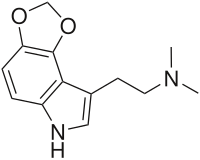From Wikipedia, the free encyclopedia
4,5-MDO-DMT
Names
Other names
4,5-methylenedioxy-N,N-dimethyltryptamine
Identifiers
ChEMBL
ChemSpider
InChI=1S/C13H16N2O2/c1-15(2)6-5-9-7-14-10-3-4-11-13(12(9)10)17-8-16-11/h3-4,7,14H,5-6,8H2,1-2H3
Key: ZMKRWFZFMOKVCP-UHFFFAOYSA-N
CN(C)CCC1=CNC2=C1C(OCO3)=C3C=C2
Properties
C 14 H 16 N 2 O 2
Molar mass
232.28
Melting point
93–95 °C (199–203 °F; 366–368 K)[ 1]
Except where otherwise noted, data are given for materials in their
standard state (at 25 °C [77 °F], 100 kPa).
Chemical compound
4,5-MDO-DMT , or 4,5-methylenedioxy-N ,N -dimethyltryptamine , is a lesser-known psychedelic drug . It is the 4,5-methylenedioxy analog of DMT . 4,5-MDO-DMT was first synthesized by Alexander Shulgin , though in his book TiHKAL psychoactive effects. 4,5-MDO-DMT has been the subject of limited subsequent testing; with behavioral disruption studies performed in male rats indicating that its hallucinogenic potency is less than that of 4,5-MDO-DiPT but greater than that of 5,6-MDO-DiPT .[ 1]
References
^ a b Kline, Toni B.; Benington, Frederick; Morin, Richard D.; Beaton, John M. (August 1982). "Structure-activity relationships in potentially hallucinogenic N,N-dialkyltryptamines substituted in the benzene moiety". Journal of Medicinal Chemistry . 25 (8): 908–913. doi :10.1021/jm00350a005 . PMID 7120280 .
External links
Tryptamines
1-Methylpsilocin 2-HO-NMT 2-Me-DET 2-Methyl-5-HT 2,N ,N -TMT 4,5-DHP-DMT 4-AcO-DALT 4-AcO-DET 4-AcO-DiPT 4-AcO-DPT 4-AcO-EPT 4-AcO-MALT 4-AcO-MET 4-AcO-MiPT 4-AcO-NMT 4-AcO-TMT 4-F-5-MeO-DMT 4-HO-5-MeO-DMT 4-HO-DALT 4-HO-DBT 4-HO-DET 4-HO-DiPT 4-HO-DPT 4-HO-DSBT 4-HO-EPT 4-HO-MALT 4-HO-MET 4-HO-McPT 4-HO-McPeT 4-HO-MiPT 4-HO-MPT 4-HO-MsBT 4-HO-NALT 4-HO-NMT 4-HO-PiPT 4-HO-pyr-T 4-HO-TMT 4-HT 4-MeO-DiPT 4-MeO-DMT 4-MeO-MiPT 4-PrO-DMT 4,5-MDO-DMT 4,5-MDO-DiPT 5-BT 5-Bromo-DMT 5-CT 5-Chloro-DMT 5-Ethoxy-DMT 5-Ethyl-DMT 5-Fluoro-DET 5-Fluoro-DMT 5-Fluoro-EPT 5-Fluoro-MET 5-HO-DiPT 5-HTP (oxitriptan) 5-MeO-2-TMT 5-MeO-34MPEMT 5-MeO-7,N ,N -TMT 5-MeO-DALT 5-MeO-DBT 5-MeO-DET 5-MeO-DiPT 5-MeO-DMT 5-MeO-DPT 5-MeO-EiPT 5-MeO-EPT 5-MeO-MALT 5-MeO-MET 5-MeO-MiPT 5-MeO-NMT 5-MeO-pyr-T 5-MeO-NBpBrT 5-MeO-T-NBOMe 5-MeS-DMT 5-Methoxytryptamine (5-MT; mexamine) 5-Methyl-DMT 5-Methyltryptamine 5-MT-NB3OMe 5-(Nonyloxy)tryptamine 5,6-MeO-MiPT 5,6-MDO-DiPT 5,6-MDO-DMT 5,6-MDO-MiPT 5,6-DHT 5,7-DHT 6-Fluoro-DMT 6-MeO-DMT 7-Methyl-DMT Acetryptine (5-AT) Aeruginascin (4-PO-TMT) AGH-107 AGH-192 AH-494 ALiPT Alpertine Baeocystin (4-PO-NMT) Benzotript (4-chlorobenzoyl-L -tryptophan) Bufotenidine (5-HTQ) Bufotenin (5-HO-DMT) Convolutindole A CP-132,484 DALT DBT Desformylflustrabromine DET DiPT DMT DPT E-6801 E-6837 EiPT EMDT EPT Ethocybin (4-PO-DET) FGIN-127 FGIN-143 FT-104 HIOC Idalopirdine Indolylethylfentanyl Indorenate Iprocin (4-HO-DiPT) Lespedamine MET Methylbutyltryptamine Miprocin (4-HO-MiPT) MiPT MPT Milipertine MS-245 MSBT N -Feruloylserotonin (moschamine)NET NMT Norbaeocystin (4-PO-T) NTBT O-4310 O -PivalylbufotenineOxypertine PiPT Psilacetin (O -acetylpsilocin; 4-AcO-DMT) Psilocin (4-HO-DMT) Psilocybin (4-PO-DMT) Pyr-T RS134-49 Serotonin (5-HT) Solypertine ST-1936 Tryptamine Tryptophan Yuremamine Z2876442907 N -Acetyltryptaminesα-Alkyltryptamines
2,α-DMT 4-HO-αMT 4-HO-MPMI (lucigenol) 4-Me-αET 4-Me-αMT 5-Chloro-αMT 5-Ethoxy-αMT 5-Fluoro-αET 5-Fluoro-αMT 5-iPrO-αMT 5-MeO-α,N ,N -TMT 5-MeO-αET 5-MeO-αMT 5-MeO-MPMI 5-Methyl-αET 6-Fluoro-αMT 7-Chloro-αMT 7-Methyl-αET α-Methyl-5-HTP α-Methylmelatonin α-Methylserotonin (5-HO-αMT) α-Methyltryptophan (αMTP) α,N -DMT (N -methyl-αMT) α,N ,N -TMT α,N ,O -TMS αET (etryptamine) αMT AL-37350A (4,5-DHP-αMT) BNC-210 BW-723C86 CP-135807 IPAP (α,N -DPT) MPMI Triptans Cyclized tryptamines
Bay R 1531 Ciclindole Cyclic 3-OHM Ergolines and lysergamides (e.g., LSD )Flucindole Harmala alkaloidsβ-carbolines (e.g., 6-MeO-THH , 9-Me-BC , β-carboline (norharman) , harmaline , harmalol , harmane , harmine , pinoline , tetrahydroharmine , tryptoline )Iboga alkaloidsDM-506 (ibogaminalog) , ibogaine , ibogamine , noribogaine , tabernanthalog , tabernanthine )Metralindole NDTDI PHA-57378 PNU-22394 PNU-181731 RU-28306 Yohimbans (e.g., yohimbine , rauwolscine , spegatrine , corynanthine , ajmalicine , reserpine , deserpidine , rescinnamine ) Related compounds

